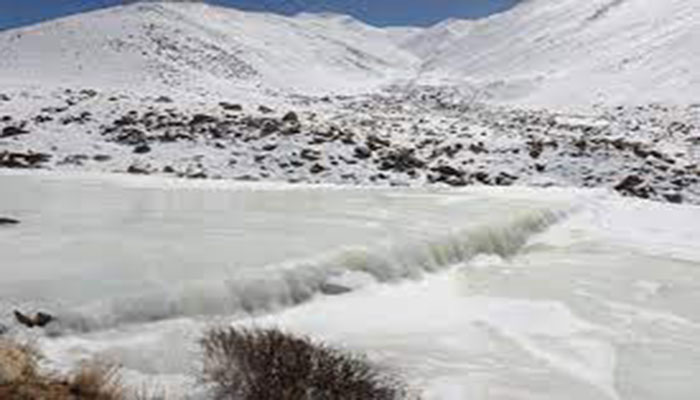Five artificial glaciers developed in GB to cut effects of climate change
ISLAMABAD: As many as five artificial glaciers have been developed in Gilgit-Baltistan in the past three years to mitigate the effects of climate change and to ensure provision of water to the residents throughout summers.
Under the umbrella of Glacier Lake Outburst Flood risk reduction Glof II- a project initiated by the Ministry of Climate Change- different universities along with locals helped in placing these gigantic stupas and glacier grafts elevated up to 4700 meters above sea level.
University of Gilgit-Baltistan, Karakuram International University Gilgit, WAFA Foundation, communities of Chundu village Skardu, Murko village in Nagar, Hussainabad village and Khuwadu village took part in this great environmental cause.
A total of three glacier grafting has been developed during the time with two in Skardu and one in District Nagar. Glacier Grafting in Kwardo Skardu was completed on October 2019 while the other two- one in Skardu and other in District Nagar- were completed on 21st December last year.
In this time, two ice stupas were also developed. One in Hussainabad Skardu and the other in Khuwardu Skardu. All of these five glaciers and ice-stupas are higher than 4000 meters above sea level except for one glacier grafting which is elevated up to 3,263 metres.
This correspondent managed to talk to an official of UNDP watching Glof II closely and a local resident of GB who explained all the procedure of making these artificial glaciers and ice-stupas to The News.
Miss Mahvish explaining the glacier grafting activity said that up to 7 to 8 feet pit is dug till it reaches the permafrost level to put glaciers in. This pit must be dug at the altitude of 4500 to 5000 meters above sea level on a screen slope shadowed by a mountain cliff so that the grafted glaciers are protected from sun, she explained.
The glaciers, according to folklore, are given male and female identities. The male glacier, “po gang” locally, is grey and covered with lot of debris, whereas the female glacier, “mo gang”, is white, shiny and debris free.
These male and female glaciers, weighing roughly 35 kg, covered with hay, are taken from different sites in chorong (willow-twig basket) to the pit dug for grafting. According to Shamsher Ali, a resident of Kharmang, apricot kernels are put at bottom of the pit. Then, hay is put, then some ice, then hay again, then apricot kernels again, then female glacier, and then finally male glacier is placed.
This practice is accompanied by hymns and rituals, sacrificing of animal being most important. The whole practice is celebrated as 'marriage of the glaciers', expected to consummate in the span of 12 years.
In ice stupa there is no moving part, no electricity is needed just gravity. Bushes are used to shape the ice stupa and it is also called skeleton of ice stupa. The shape of ice stupa helps in storing water vertically enabling the ice to remain frozen by reducing surface area that is exposed to sun as compared to the other artificial glaciers. According to Mahvish (UNDP spokesperson), ice stupas are observed on the weekly basis and are expected to supply water to the thousands of residents in the time of summers.
-
 Northern Lights Glow Across US, UK , Europe After ‘rare’ Solar Storm Hits
Northern Lights Glow Across US, UK , Europe After ‘rare’ Solar Storm Hits -
 Karol G Parts Ways With Beau Feid After Three Years Of Dating
Karol G Parts Ways With Beau Feid After Three Years Of Dating -
 'DWTS' Pro Gleb Savchenko's Mystery Love Interest's Identity Revealed
'DWTS' Pro Gleb Savchenko's Mystery Love Interest's Identity Revealed -
 Meghan Markle’s Father ‘plans To Leak’ Her Letter Despite Privacy Efforts?
Meghan Markle’s Father ‘plans To Leak’ Her Letter Despite Privacy Efforts? -
 Woody Harrelson Reveals Creative Clash With Matthew McConaughey On 'True Detective'
Woody Harrelson Reveals Creative Clash With Matthew McConaughey On 'True Detective' -
 Brooklyn Beckham Reveals Major Cause Behind His Feud With Parents
Brooklyn Beckham Reveals Major Cause Behind His Feud With Parents -
 Timothée Chalamet's 'Marty Supreme' Makes Big Record
Timothée Chalamet's 'Marty Supreme' Makes Big Record -
 Prince Harry Faces Brutal Online Taunts After UK Court Appearance
Prince Harry Faces Brutal Online Taunts After UK Court Appearance -
 OpenAI Surpasses $20 Billion Revenue In 2025, Says CFO
OpenAI Surpasses $20 Billion Revenue In 2025, Says CFO -
 Amanda Batula, Kyle Cooke Call It Quits After 4 Years Of Marriage
Amanda Batula, Kyle Cooke Call It Quits After 4 Years Of Marriage -
 Elijah Wood Gets Candid About Brutal 'Lord Of The Rings' Shooting
Elijah Wood Gets Candid About Brutal 'Lord Of The Rings' Shooting -
 Ellie Goulding Drops Rare Video Of Boyfriend Beau Minniear During Paris Trip
Ellie Goulding Drops Rare Video Of Boyfriend Beau Minniear During Paris Trip -
 Rihanna Hit By Hotel Door In New York, Jokes With Bodyguard Afterward
Rihanna Hit By Hotel Door In New York, Jokes With Bodyguard Afterward -
 Meghan Markle's Decision To Cut Out Raw Moment With Harry Sparks Explosion
Meghan Markle's Decision To Cut Out Raw Moment With Harry Sparks Explosion -
 Prince Harry Faces ‘massive Strain’ On His Life Due To UK Media
Prince Harry Faces ‘massive Strain’ On His Life Due To UK Media -
 Timothy Busfield Booted From Penn Badgley Starrer Rom-com After Arrest
Timothy Busfield Booted From Penn Badgley Starrer Rom-com After Arrest




